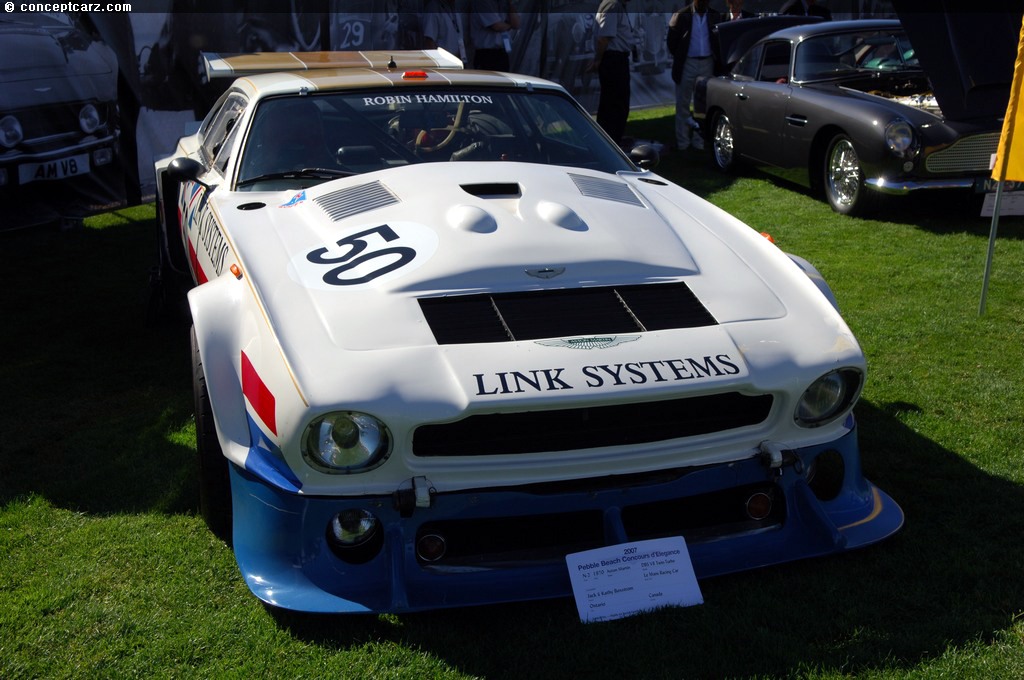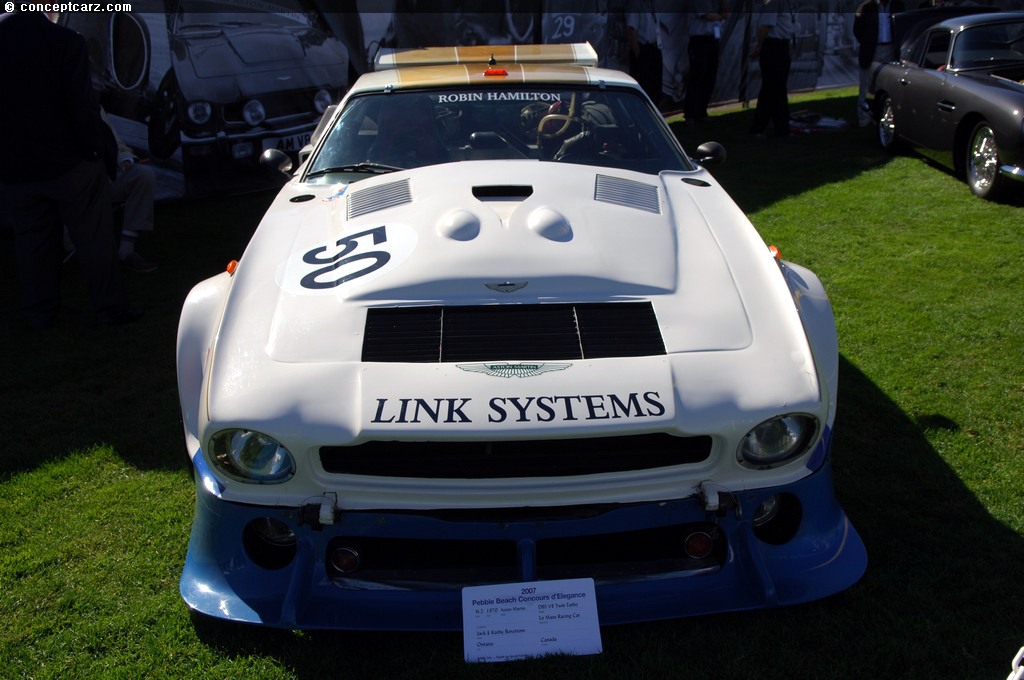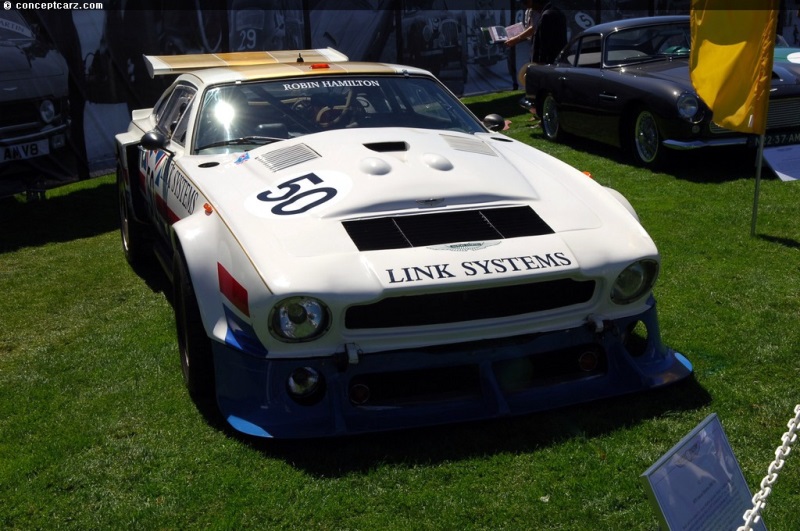This Aston Martin DBS V8 occupies a special place in the history of the marque at Le Mans. Prepared by Robin Hamilton and co-driven by him, David Preece and Mike Salmon, this car finished 17th overall and 3rd in the GTP class at the 1977 Le Mans 24-Hour endurance race, an event few critics believed the team would finish.
Coupe
Chassis #: 10038
View info and historyStaffordshire based Aston Martin specialist Hamilton had conceived the idea of racing one of the V8-engined cars in 1974, campaigning this example, chassis number 10038, in lightly modified form in club events. The first major alterations were made to conform to Group 4 regulations and bring the car into line with the then current production AM V8 by fitting the latter's two-headlamp front end. With Le Mans the eventual target, the car was further developed to incorporate modified cylinder heads, revised camshafts, side-draft Weber carburettors and a race exhaust system, while the running gear was up-rated with stiffer springing, bigger brakes, wider wheels and slick tyres. In this form 10038 raced in AMOC events throughout 1975 before gaining a quartet of dragster-style downdraft Webers for 1976.Failure to drum up sufficient sponsorship meant that the 1976 Le Mans race was missed, which if nothing else allowed the team time for extra development, including a dynamometer session at the Newport Pagnell factory in November/December of that year. The factory also paid for wind tunnel testing at MIRA, a highly beneficial exercise that resulted in low-drag, increased downforce bodywork that would later appear on the production Vantage model. Sponsorship by SAS, a security equipment company, financed the 1977 Le Mans effort, prior to which the car raced at the Silverstone Six Hours on 15th May supported by donations from individual AMOC members. By this time the V8 engine was developing 520bhp, an output calculated to produce speeds of a magnitude requiring a rear wing to counter lift, though the presence of this un-homologated modification meant that the Aston was now in Group 5 alongside the turbocharged Porsches. The chassis too, had undergone considerable modification, prompting the team to give it the number RHAM 001 (Robin Hamilton Aston Martin 001). In the Silverstone race, 55 minutes were lost to repairs but the exercise proved useful in revealing that the differential needed additional cooling.For Le Mans, third driver Mike Salmon was recruited to join Hamilton and David Preece, who had driven the car at Silverstone. A Le Mans veteran, Salmon had driven the last Aston to race at the Sarthe, Peter Sutcliffe's Project 214, in 1964. A request to move to the GTP category, where opposition was deemed less strong, having been granted by the organisers, the Aston qualified slowest in class after recording an impressive 188mph along the Mulsanne straight during practice. In the race itself, Hamilton drove the opening stint followed by Preece and then Salmon, the Aston picking up numerous places before, at a routine stop at 10.19pm, cracks were discovered in the front brake discs. They were replaced in a stop lasting 31 minutes, but a lack of further spares meant that conservation was the order of the day for the remainder of the race. The only other serious problem encountered was a split differential oil tank that needed regular patching and topping up. Running steadily to the flag, the Aston Martin crossed the finish line after 2,210.78 miles of racing with Robin Hamilton, who had driven longest of the three drivers, at the wheel. It gave Hamilton immense satisfaction, not only because he had achieved a lifelong ambition by driving an Aston Martin across the Le Mans finishing line, but also because by so doing he had confounded the pundits who claimed that the heavyweight DBS V8 was totally unsuitable for racing.
Coupe
Chassis #: 10038
View info and historyHamilton continued to develop 10038, which was not used in 1978 but next appeared at the Silverstone Six Hours in May 1979, considerably lightened and re-modeled with a lower roof line, while beneath the bonnet was a twin-turbocharged version of the Aston V8 engine producing 650bhp in race trim. Driven by Preece and Le Mans-winner Derek Bell, the car finished in midfield having been hampered by brake and oil breathing problems. At Le Mans, the V8 proved capable of lapping several seconds quicker than in 1977, but in the race itself retired with a melted piston during the third hour. The car's next competitive outing, at Silverstone in 1980, ended in early retirement. As a footnote to its racing career, 10038 set a new World Land Speed Record for towing a caravan later that year, when Robin Hamilton towed an Alpha 14 van to 125mph (mean) having seen 152mph on the clock exiting the timed quarter-mile!10038 was offered for sale at Bonhams' Aston Martin Auction held on the May 13th, 2006 at Works Service, Newport PagnellSource - Bonhams

Coupe
Chassis #: 10038
View info and history

Coupe
Chassis #: 10038
View info and history
Related Reading : Aston Martin Aston V8 History
The Aston Martin V8 was produced from 1969 through 1990 and was, of course, powered by an eight-cylinder engine. For many years eager customers had been pleading with Aston Martin to produce an eight-cylinder car. Expected to be completed by 1967, the engine took a few more years of development before being ready. In the meantime, Aston Martin introduced the DBS which borrowed its Vantage six-cylinder....
Continue Reading >>
Continue Reading >>
Aston Martin
Similar Automakers
Similarly Sized Vehicles
from 1970
1970 Aston Martin DBS V8 Vehicle Profiles
Recent Vehicle Additions
Related Automotive News

Record-Setting Acura TLX GT Coming to Amelia Island
Record-setting Pikes Peak International Hill Climb Acura TLX GT coming to 2024 Amelia Island Concours dElegance
All-Wheel-Drive RealTime Racing Acura is a three-time winner at Pikes Peak
Driver Peter Cunningham piloted the Acura TLX GT to Open C...

McLaren P1: Celebrating 10 years of the pioneering hybrid hypercar heralded as the 'best driver's car on road and track'
The first McLaren Ultimate model was revealed in final production form at the Geneva International Motor Show in March 2013
McLarens hybrid hypercar was announced with the goal of being the best drivers car in the world on both road and track
...

From the PEUGEOT 905 to the PEUGEOT 9X8: 30 years of outstanding innovation and performance
From the 1991 PEUGEOT 905 to the 2021 PEUGEOT 9X8 30 years of outstanding innovation and performance
For more than 210 years, PEUGEOT has been moving with the times, anticipating changes in customer behaviour and paving the way for new mobility...

Vantage: Sports Car Superiority For 70 Years
2020 marks the 70th anniversary of the Vantage name
More than 36,000 cars sporting the Vantage moniker have been meticulously handcrafted over the last seven decades
Vantage family of models includes some of Aston Martins most successf...

Racing legends reveal the thrill of 'Motor Racing in the 1970s' at the Credit Suisse Historic Racing Forum
A full house of VIPs and members of the media flocked to the iconic Race Control building at Goodwood Revival on Saturday 14 September 2019 for the highly anticipated Credit Suisse Historic Racing Forum.
Before track action officially got under...














